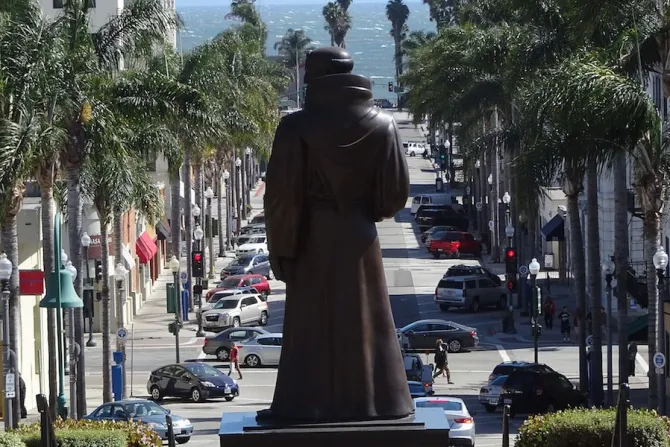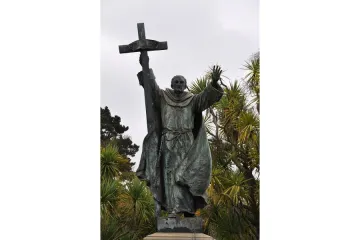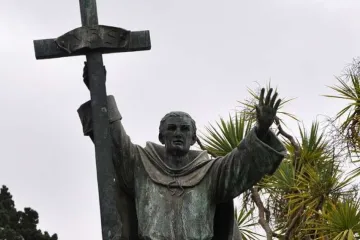CNA Staff, Jun 22, 2020 / 14:08 pm
While statues of St. Junipero Serra have been taken down by protestors in California cities, the mission church in Ventura, California, founded by the saint, has announced it will work with local officials and indigenous tribal leaders to see a Serra statue outside Ventura City Hall moved to "a non-public location."
The announcement came days before a statue of St. Serra was torn down in San Francisco's Golden Gate Park June 20, along with statues of Francis Scott Key and Ulysses S. Grant. In Los Angeles the same day, rioters pulled down a statue of Serra in the city's downtown.
"Some people disagree with the way that I am handling this, and that's ok. Some people agree. Some people have even asked that I should be pastor of a mission. Well, everyone is entitled to their own opinion," Father Tom Elewaut, pastor of the San Buenaventura mission church, said in a homily on June 21.
"The statue is up today, isn't it? And that is due to not only the joint statement, but the strong position of the elders of the Chumash, who are local here. We want to see the statue preserved. It needs to be relocated- it could have very well been toppled yesterday," the priest said.
Though protestors rallied at the bronze statue in Ventura on June 20 and reportedly called for it to be torn down, Chumash tribe elders have been adamant that they want a peaceful solution.
"We are going to become a model for the nation so it's not this riot mob act and desecration, and even having a statue broken into pieces. That is our goal, and that we hope will come to fruition," Elewaut added.
Across the country, protestors and rioters this week have pulled down statues of historic figures- some depicting Confederate figures, as part of a call to end systemic racism, but others depicting such figures as George Washington and Grant.
Some California activists view Serra, an 18th-century Franciscan missionary, as having contributed to the destruction of Native American way of life through his founding of the first nine of California's mission churches. Many of the priest's biographers dispute those claims.
Elders of the Chumash Native American tribe met last week with Ventura Mayor Matt Lavere and Fr. Elewaut.
"The three of us are confident that a peaceful resolution regarding the Father Junipero Serra statue can be reached, without uncivil discourse and character assassination, much less vandalism of a designated landmark," the parties said in a June 18 joint statement.
"We all believe that the removal of the statue should be accomplished without force, without anger, and through a collaborative, peaceful process. This process has already commenced through our initial meeting and we look forward to continuing the discussion with the community to help guide further action on this."
The proposal to remove the statue, which was dedicated in 1989, will need to go before the city council, the parties said, and a formal removal decision has not yet been made.
A similar statue was beheaded at the Old Mission Santa Barbara in 2017, and red paint was used to graffiti the mission in 2018, Ventura's ABC affiliate reported.
Pope Francis canonized Serra in Washington, D.C. on Sept. 23, 2015, saying that "Junípero sought to defend the dignity of the native community, to protect it from those who had mistreated and abused it,"
Father Elewaut, said in his Sunday homily that while it is true that many Native Americans died after contact with Europeans, "it wasn't a purposeful or contrived death" because most of them died of disease, which no one at the time fully understood.
Father Elewaut was present at the June 20 rally, and said he hopes the peaceful dialogue in which he and the Chumash elders have so far been engaged can be a model for the nation, to show that controversial statues need not be torn down by force.
(Story continues below)
The idea that Serra created what were akin to "concentration camps" for the Natives is "categorically false," Elewaut said.
"The blame cannot be put on one person, or one movement...but the hurt that they feel, the the pain that we should join with them in feeling is true, and it remains true, and it will remain true whether our statue stands or not,"
"But if [the removal] brings some healing, if that brings some peace of mind, then so be it...statues come and go, but the truth will be laid bare," the priest said, acknowledging that the statue will be removed from its current location, but the Church's mission will continue.
The mission will continue to be a sign of God's grace, regardless of the location of any particular statue, he said.
"Serra wanted to share what he truly believed to be the great gift of Christianity, of Catholicism, of sacramental life," the priest said.
Elewaut said he has been working with the elders of the Chumash tribe, for whom he has "profound respect." He hopes to continue to work with the Chumash, some of whom are parishioners at the mission.
Elewaut told Ventura's ABC affiliate that the Archdiocese of Los Angeles is open to moving the statue from City Hall to mission grounds. The LA Archdiocese did not confirm this by time of posting.
Serra was instrumental in founding the first nine of the 21 missions in California, many of which would form the cores of what are today the state's biggest cities- such as San Diego, San Francisco, and Los Angeles.
A native of Petra Mallorca in Spain, Serra was a renowned scholar who gave up his academic career to become a missionary in North America.
Serra arrived in Mexico City in 1750, entering the vast territory of New Spain. The Spanish had been in North America for over 200 years at that point, after Hernan Cortez' conquest of the Aztec Empire in 1521.
While many activists today associate Serra with the abuses that the Native Americans suffered, biographies and historical records suggest that Serra actually advocated on behalf of the Natives against the Spanish military and against encroaching European settlement.
Archbishop Salvatore Cordileone of San Francisco decried "mob rule" that led to the tearing down of Serra's statue in his city.
Cordileone said in a statement June 20 that he did not want to "deny that historical wrongs have occurred, even by people of good will, and healing of memories and reparation is much needed. But just as historical wrongs cannot be righted by keeping them hidden, neither can they be righted by re-writing the history."
The archbishop praised the saint's missionary zeal: "St. Junipero Serra also offered them the best thing he had: the knowledge and love of Jesus Christ, which he and his fellow Franciscan friars did through education, health care, and training in the agrarian arts."
In 2018, San Francisco's city government removed a statue of the saint from a prominent location outside City Hall. A statue of the saint remains on display in the U.S. Capitol.




